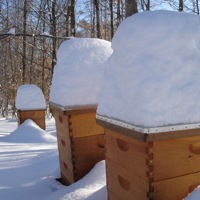Paul currently keeps four hives near the house and is working on establishing a second apiary a mile or so away. The setting is quite picturesque, surrounded by blossoming redbuds and fruit trees. And of course, there's also the electric fence to keep out the bears.
After donning veils and lighting the smoker, we opened up the hives to take a look. All colonies are already very strong, with plenty of nectar coming in. The honey flow seems to be almost a month early this year. One colony had already swarmed, as evidenced by several empty queen cells on the combs (see photo below).
Paul uses styrofoam hive bodies for his bottom two brood boxes. He says the added insulation keeps the bees warmer in winter and cooler in summer. You might think Thomas Jefferson had no access to styrofoam, but a little known fact turns out to be that...just kidding. Actually, Jefferson predated even the modern Langstroth hive. In his time bees would have been kept in skeps - those inverted dome-like baskets. We asked Paul if Management gave him a hard time about that. He said there were some raised eyebrows initially, but he convinced them his way was healthier for the bees.

 You can see the empty queen cell on the right side of the above photo. Just after the old queen left the hive with a swarm of bees to establish a new colony, a new queen emerged from this cell and fought to the death with other emerging queens. The winner is busy laying eggs and building the population of this colony.
You can see the empty queen cell on the right side of the above photo. Just after the old queen left the hive with a swarm of bees to establish a new colony, a new queen emerged from this cell and fought to the death with other emerging queens. The winner is busy laying eggs and building the population of this colony.
Before we left, Paul handed us a jar of honey made by Monticello's very own honey bees. We'll open it up for our dinner event in May. Thanks for hosting us Paul! Some more photos of our visit are here.































 Honeybees survive by acquisition, defense, and efficient
allocation of various resources, to enable successful
overwintering and reproduction. This requires
sophisticated decision making, akin to that needed by
manufacturing firms, and beyond the capability of a single bee's
brain. But when each bee follows simple
sets of rules, the aggregate effect creates an emergent
intelligence for the colony as a whole, able to react to a
dynamic environment and achieve complex optimizations.
Honeybees survive by acquisition, defense, and efficient
allocation of various resources, to enable successful
overwintering and reproduction. This requires
sophisticated decision making, akin to that needed by
manufacturing firms, and beyond the capability of a single bee's
brain. But when each bee follows simple
sets of rules, the aggregate effect creates an emergent
intelligence for the colony as a whole, able to react to a
dynamic environment and achieve complex optimizations.
 We're interested in understanding some of the
mathematical principles underlying the colony
intelligence of honeybees. We meet roughly every other
week from October through April to discuss articles
from the scientific literature on honeybees. We also
do some mathematical modeling of specific honeybee
optimization behaviors. Along the way, we learn some
aspects of honeybee biology and ecology, as well as
the history and practice of beekeeping.
We're interested in understanding some of the
mathematical principles underlying the colony
intelligence of honeybees. We meet roughly every other
week from October through April to discuss articles
from the scientific literature on honeybees. We also
do some mathematical modeling of specific honeybee
optimization behaviors. Along the way, we learn some
aspects of honeybee biology and ecology, as well as
the history and practice of beekeeping.
 We're also interested in getting to know each other,
and getting to know the bees. In the Fall and Spring, we
meet regularly at Professor Gromoll's home for
hands-on activities in the apiary. This includes an
opening breakfast in the Fall, and a dinner in the
Spring. We'll also start a new honeybee colony for the
group, and take a field trip to a larger apiary in the
area.
We're also interested in getting to know each other,
and getting to know the bees. In the Fall and Spring, we
meet regularly at Professor Gromoll's home for
hands-on activities in the apiary. This includes an
opening breakfast in the Fall, and a dinner in the
Spring. We'll also start a new honeybee colony for the
group, and take a field trip to a larger apiary in the
area.





